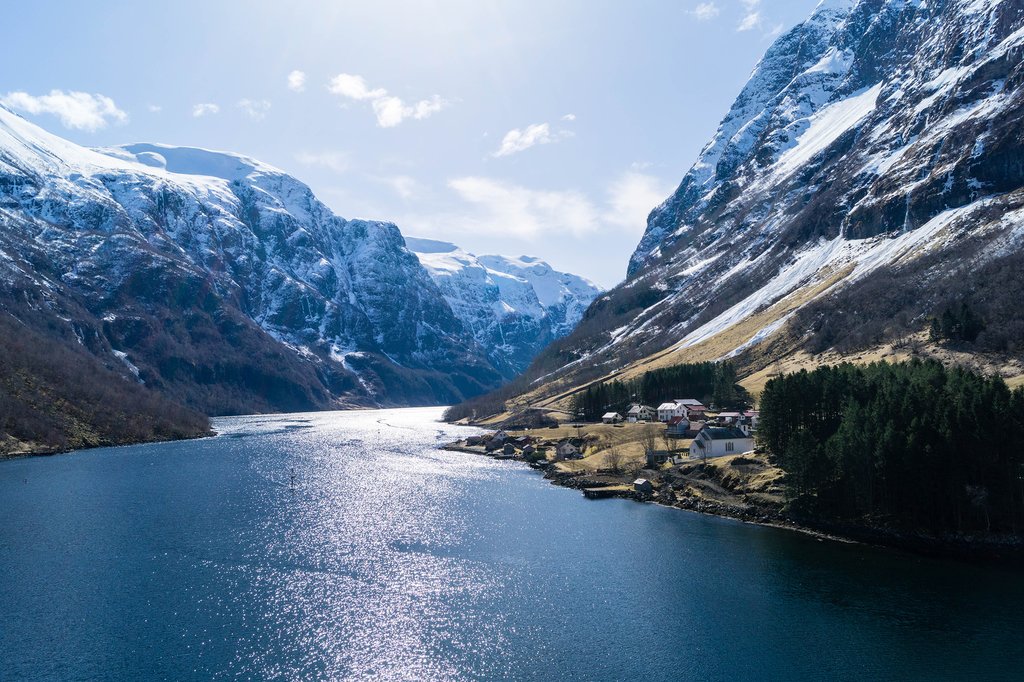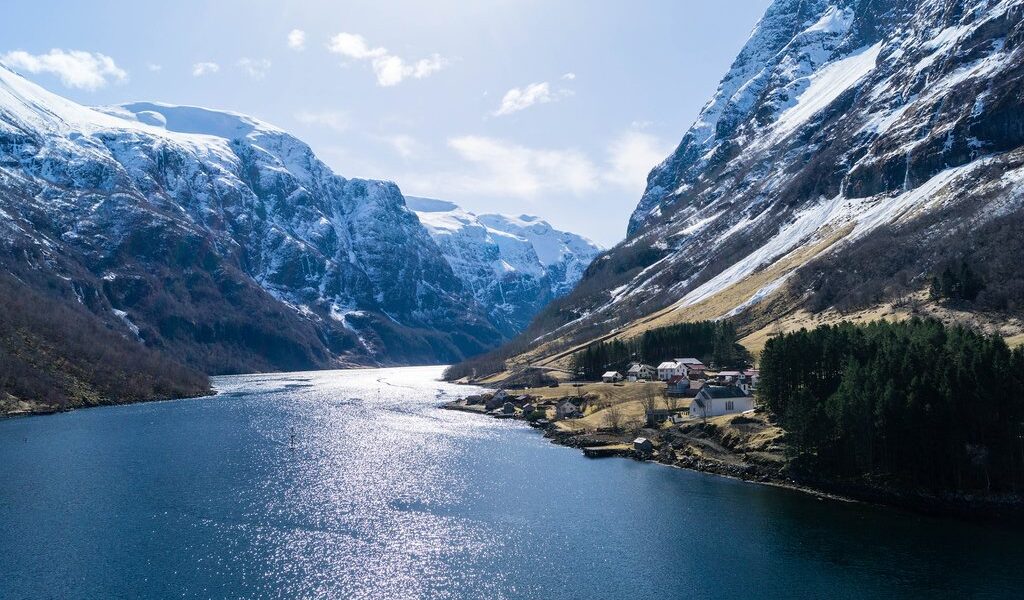
Despite the chilly, wet weather, Norway’s long, dramatic coastline offers winter sports and local festivals—as well as fewer tourists and lower prices. February is also a great time for taking a fjord cruise and catching the Northern Lights before they disappear in the spring. Read on to learn more.
Weather in the Norwegian Fjords
Norway’s fjords, a breathtaking tapestry of natural wonders, extend for an impressive 1,581 miles (2,544 km) along the captivating Atlantic coast. This expansive region, characterized by a diverse range of altitudes, experiences weather patterns that are known for their frequent and sometimes dramatic changes. Due to its sheer size, it’s wise to prepare for anything. One of the most significant influences on the climate of the Norwegian fjords is the warm water of the Gulf Stream. This oceanic current plays a crucial role in moderating temperatures, creating a milder and wetter climate compared to the inland regions of central Norway. As a result, the winter months in the fjords often feel less harsh and bitter than in other parts of the country.
To illustrate the climatic variations within the fjords, consider the coastal city of Ålesund. In February, Ålesund experiences an average high temperature of 40° F, with a low of 34° F. In stark contrast, the inland town of Røros, situated further from the coast, has an average high temperature of 25° F and a low of 6° F during the same period. These temperature differences highlight the impact of the Gulf Stream and altitude on the local weather. For those who enjoy winter sports, the high-altitude fjords and the surrounding mountains offer excellent snow conditions for skiing. Whether you’re planning a visit to Ålesund, Røros, or any other location within the fjords, it’s essential to be prepared for sudden weather changes. A flexible and laid-back attitude will undoubtedly enhance your overall experience.
Furthermore, the days in February bring a noticeable increase in daylight hours compared to the preceding month of January. In Bergen, for example, you can expect to enjoy approximately 8 to 9 hours of daylight during February. Even in Tromsø, located above the Arctic Circle, the daylight hours range from 6 to 9 hours, providing ample time for exploration and activities. These increasing daylight hours contribute to a more vibrant and enjoyable atmosphere in the fjords during February.
Crowds and Costs in February
With the notable exceptions of ski resorts and unique ice hotels, February is generally considered the offseason for travel in the fjords. The daylight hours, while increasing, are still relatively short compared to the summer months. This makes February a quieter time to explore Norway, resulting in lower prices for flights and accommodations. If you prefer a more relaxed and uncrowded travel experience, February offers an excellent opportunity to immerse yourself in the spectacular scenery of the fjords at your own pace. The cozy and inviting atmosphere after dark, coupled with increased opportunities for interacting with locals, adds to the charm of visiting during this time of year.
Where to Explore in the Fjords
The Norwegian fjords, with their nearly 1,200 distinct formations stretching along the Atlantic coast from north to south, present an endless array of vistas, charming villages, and culturally rich towns waiting to be discovered. For travelers who are willing to bundle up and embrace the unpredictable weather, the fjords offer a truly unforgettable experience. Due to the prevailing snow conditions in the mountains during February, traveling around the fjords often involves a combination of short flights, ferry rides, and/or cruises on the renowned Hurtigruten ships. Long, scenic road trips are generally better suited for the spring and summer months, unless you are equipped with a capable 4×4 vehicle designed to handle the winter conditions.
Many travelers begin and end their fjord journeys in Oslo, the rapidly growing capital city of Europe. Oslo boasts a sophisticated cultural scene and stunning views of the Oslofjord. From Oslo, a popular route is to head west towards fjord-side hubs such as Trondheim, a vibrant university city. Other architecturally significant cities like Bergen and Ålesund also serve as excellent bases for day trips to explore the surrounding fjords.
For a unique experience, consider venturing north of the Arctic Circle to explore the fjords. The fishing villages in the Lofoten Islands are particularly appealing in February, offering a chance to avoid the larger tourist crowds that gather during the summer months. The Lofoten Islands, with their dramatic landscapes and charming settlements, provide a truly unforgettable Arctic adventure.
Activities and Experiences in February
The increasing daylight hours in February provide more opportunities to enjoy a wide range of activities and excursions in the fjords. Additionally, February is host to unique outdoor festivals (as detailed below) that celebrate the natural light and winter traditions of the region. If witnessing the mesmerizing Aurora borealis, also known as the Northern Lights, is high on your list, February offers frequent sightings, particularly above the Arctic Circle, before the arrival of the spring season.
Certain fjords, such as those near the Lyngen Alps and the Hardanger region, are renowned for their excellent Nordic ski slopes. These areas attract a significant number of visitors in February due to the exceptional snow conditions. Meanwhile, those with an appreciation for culture will find much to admire in Norway’s centuries-old wooden architecture. The country boasts several UNESCO-listed sites, including Bryggen, Bergen’s colorful and historic wharf. A visit to Bryggen offers a glimpse into the region’s rich maritime past and architectural heritage. You can easily combine cultural experiences with outdoor activities. For example, you can hit the slopes near the charming ski town of Sogndal, which is located on an inlet of the Sognefjord, Norway’s longest and deepest fjord.
Consider breaking up your skiing adventures with a ferry ride to visit a remarkable 13th-century wooden church, a testament to the region’s rich history and craftsmanship. Alternatively, you can drive to the Fjærlandsfjord and explore the fascinating Norwegian Glacier Museum, which provides insights into the formation and dynamics of glaciers. Another unique attraction is the Norwegian Booktown, a haven for book lovers, featuring several second-hand bookshops, some of which are combined with inviting cafés, art galleries, and souvenir shops.
For those seeking more adventurous pursuits, February in the fjords offers opportunities for snowmobiling, sleigh riding, dog and reindeer sledding, winter fishing, and even surfing and snorkeling, thanks to the moderating influence of the Gulf Stream’s warm waters. Gourmands will delight in the impressive array of restaurants in cities like Tromsø, often referred to as the ‘Paris of the North’. Norway’s captivating coastline also attracts cruise passengers seeking fjord day trips or longer, more leisurely voyages. These cruises are especially popular among photographers looking to capture the stunning landscapes. Young European backpackers often utilize Hurtigruten ships as a convenient mode of transportation between towns, further enhancing the vibrant atmosphere of the fjords.
Events in February in the Norwegian Fjords
ISFIT. This distinctive cultural festival, held in Trondheim during odd-numbered years, is a student-organized international youth gathering that attracts participants from over 100 countries. The festival features a diverse range of concerts and events designed to fill the winter leisure hours with enriching and engaging experiences.
Kristiansund Opera Festival. This annual festival, held in the charming town of Kristiansund, presents a diverse program of classical, opera, and ballet performances, alongside art exhibitions and other captivating cultural events. The Kristiansund Opera Festival is a highlight of the region’s cultural calendar.
Birken Skifestival. In Rena, the birthplace of slalom skiing, the Birken festival is celebrated every winter, typically in February. This traditional event traces the same route taken by a group of skiers during Norway’s civil war in the 1200s, when they carried the young prince Haakon Haakonsøn to safety. Today, participants are required to wear a backpack as a symbolic representation of carrying the weight of that child, adding a meaningful layer to the competition.
Sami Week. Taking place during the week of Sami National Day, this February festival celebrates the rich cultural heritage of the Sami people. The festival includes the national reindeer racing championship, where Sami drivers lead reindeer in a thrilling sprint along Tromsø’s main street. In addition to the races, Sami Week features a variety of cultural events, including exhibitions, markets, seminars, and concerts, providing a comprehensive immersion into Sami traditions and culture.
Planning Your Trip to Norway in February
Planning a trip to Norway in February opens the door to a realm of extraordinary experiences, from witnessing the mesmerizing Northern Lights to exploring picturesque fjords draped in winter’s embrace. Here are some itinerary ideas that cater to diverse interests and preferences:
Check out spectacular Norwegian scenery via the nation’s efficient network of ferries, trains, and buses. Start off with a day in Oslo before making your way to Eidfjord, a village right on the Hardangerfjord. Ferry to Utne (another town on the fjord) and finish the week ferrying to seaside Bergen—a UNESCO-listed city known for its seven mountains.
Start in Tromsø, the ‘Paris of the North’ —your base for several snow activities. Then set sail on the Hurtigruten to explore the Lofoten Islands before continuing (by sea) towards the city of Trondheim, the UNESCO-listed village of Røros, and finally a night in Oslo.
B-1924

